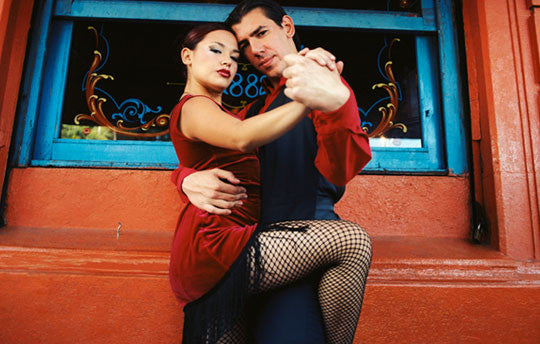Your Cart is Empty

Forget the ballroom image, tango is a real roots music: always sensuous, rhythmic and passionate, the vertical expression of a horizontal desire.
Tango began was an urban music of Buenos Aires in the late 1800s. As a product of a mixture of cultures, tango was forged from a range of musical influences and imbued with immigrant history. In its early form, tango became associated with the life of compadrítos – knife-wielding, womanising thugs. The compadrítos danced in low-life cafés with a showy yet threatening, predatory quality and thus danced the tango into existence.
The original ensembles were trios of violin, guitar and flute. The bandoneón, tango accordion, appeared at the end of the nineteenth century and the classic tango orchestra was born. Vicente Gréco is credited as the first bandleader to standardise the tango group form with two violins and two bandoneóns, which remained unchanged until the 1940s.
Brought to Europe by Ricardo Guïraldes, a rich playboy who spent time with the compadrítos, tango was the first Latin dance crazes to conquer Europe.
Tango soon made it to Hollywood when Rudolph Valentino performed in a tango scene at the end of the film The Four Horsemen of the Apocalypse (1926). In the scene, Valentino plays a gaucho (Argentinian cowboy) though gauchos never danced the tango. The tango scene was the hit of the film and, inaccurate as it was, it meant the dance was now known all over the world.
In the 1920s, tango moved out of the Argentinean bordellos and into cabarets and theatres marking the classic era. This period saw some of the most famous tangos ever written including “La Cumparsíta” by Gerárdo Hernán Matos Rodríguez.
The classic tango lyric of a male perspective was introduced, and featured lyrics where men were victims of women’s capriciousness. The dance reflects this in an almost violent and dangerous friction of bodies where a glittering respectability hid darker undercurrents in the obvious macho domination of the male over the female.
 The Rough Guide To Tango Legends: Carlos Gardel
The Rough Guide To Tango Legends: Carlos Gardel
Carlos Gardél was – and still is – a legend in Argentina and was a huge influence in spreading the popularity of tango. It was Gardél who transformed tango from an low-down dance form to a song style popular among differing social classes. His voice became the model of all future singers of the genre. Gardél recorded some nine hundred songs and starred in numerous films before his tragic death in an aircrash.
After Gardél, a mass following for tango was enjoyed until the end of the Golden Age around 1950.
Tango declined slightly in the 1930s when the army took power and suppressed what was seen as a subversive force. Even so, bandleader Juan D’Arienzo was a large figure throughout. Tango fortunes revived again in the 1940s when a certain political freedom returned and the music enjoyed a second golden age and a new generation of bandleaders. During this era, tango began to move into the middle class. It became a collective reminiscence and nostalgia. In the 1950s, with the coming of rock’n’roll, tango slipped into the shadows once again.
Astor Piazzolla dominates the recent history of tango. He played for Carlos Gardél at an early age and later with Aníbal Troilo’s orchestra. He studied composition in Paris and was encouraged to develop the popular music of his heritage. Piazzolla’s idea was that tango could be a serious music to listen to, not just for dancing. His influence spread and his experiments were an international success, which opened the way for other radical transformations.
By the 1970s, the fusion tango-rockéro was developed that included a rock-style rhythm section, electric guitars and synthesizers. Tango also moved across to jazz through groups like Siglo XX. Meanwhile, traditional tango was being kept alive by two key figures, Roberto Goyeneche and Osvaldo Pugliese.
Today, the tango scene is a pretty broad one. The big tango orchestras, however, are a thing of the past. Bands have returned to the intimate ensembles, like Sexteto Mayór. Singers are successfully renovating and re-creating tango.
Tango is enjoying a upsurge of popularity in Argentina and other parts of the world where couple dancing seems back in fashion.